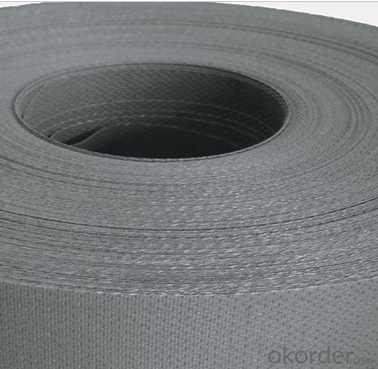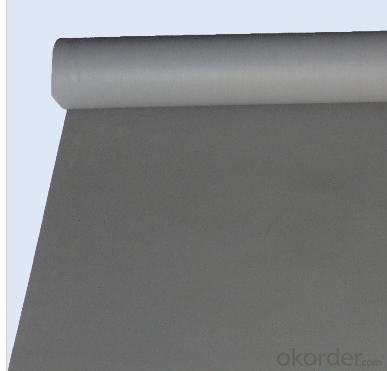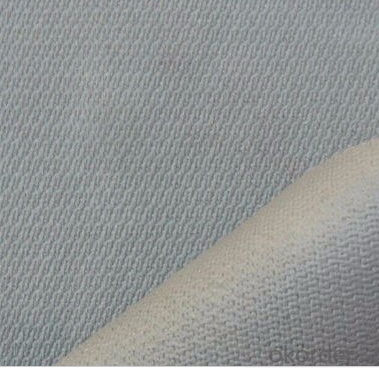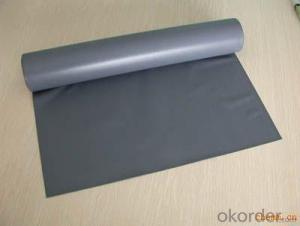Silicone Coated Fiberglass Fabrics with High Quality and Best Price
- Loading Port:
- China Main Port
- Payment Terms:
- TT or LC
- Min Order Qty:
- 30 square meters m²
- Supply Capability:
- -
OKorder Service Pledge
OKorder Financial Service
You Might Also Like
1 Introduction:
Silicon coated fiberglass fabrics are the mutilfunctional thermal insulation material with high performance.

2.Properties
Advance coating technology and special formula contribute to the following advantages.
a:Superb electric insulation
b:Inert to majority of chemical reagents
c:Water repellent and oil repellent
d:Soft and pliable,easy to tailor and good processing performance
3.Application
Fireproof curtains, fireproof blanket
Thermal insulation and anti-corrosion for pipe
Welding protection
4 Specifications

Product code | Thickness mm | Parting intensity (N/50mm) | Inflating burst intensity Mpa | Peeling intensity N/m | Capability of flameproof | Weight | |
Warp | Weft | ||||||
FGS-030-L | 0.30+0.03 | ≥1600 | ≥1200 | ≥1.2 | ≥450 | FV-0 | 400+40 |
FGS-035 | 0.35+0.03 | ≥1800 | ≥1400 | ≥1.2 | ≥450 | FV-0 | 470+50 |
FGS-045-L | 0.45+0.04 | ≥1800 | ≥1400 | ≥2.0 | ≥450 | FV-0 | 630+60 |
FGS-050 | 0.50+0.05 | ≥2000 | ≥1600 | ≥2.0 | ≥450 | FV-0 | 640+60 |
FGS-3784-080-L | 0.80+0.08 | ≥3000 | ≥2500 | ≥1.2 | ≥450 | FV-0 | 1000+100 |
FGS-110 | 1.10+0.10 | ≥3800 | ≥3400 | ≥2.6 | ≥450 | / | 1700+170 |
FGS-150 | 1.50+0.10 | ≥3200 | ≥2800 | ≥3.0 | ≥450 | / | 2300+3 |
Packaging:packed in rolls, with bubble bags and woven bags

FAQ:
1.What is the delivery time ?
15days after receiving the deposit
2.Are you a trading company or factory.
We are factory,and we have more than 10 years of experience.
- Q:What are the different thicknesses available for fiberglass fabric?
- Fiberglass fabric is available in various thicknesses to cater to different applications and requirements. The most common thicknesses range from 0.5 ounces per square yard (osy) to 3.0 osy. However, it is important to note that the thickness of fiberglass fabric is measured in weight per square yard rather than physical thickness. The thinnest fiberglass fabric options, such as 0.5 osy, are often used in applications where a lightweight and flexible fabric is required. These fabrics are commonly used in industries like aerospace, automotive, and marine, where weight reduction and flexibility are crucial factors. On the other hand, thicker options like 1.5 osy to 3.0 osy are typically used for applications that require higher strength and durability. These fabrics are commonly used in industries like construction, insulation, and industrial manufacturing, where a stronger and more rigid material is necessary. It is worth mentioning that fiberglass fabric can also be customized to suit specific thickness requirements. Manufacturers can tailor the fabric's weight per square yard to meet the desired specifications of a particular project. In conclusion, fiberglass fabric comes in various thicknesses, ranging from 0.5 osy to 3.0 osy, to satisfy different applications' needs. The selection of the appropriate thickness depends on factors such as the desired strength, flexibility, weight reduction, and durability required for the specific project or industry.
- Q:What are the differences between Geogrid, glass fiber network and geotextile?
- Glass fiber mesh used in exterior wall, interior wall paint, mainly to prevent cracking, different materials at the junction of mortar plastering material hollowing. Local node reinforcement will also be used.
- Q:What are the different fiberglass fabric finishes for water resistance?
- There are several different fiberglass fabric finishes that provide water resistance. One commonly used finish is silicone, which forms a waterproof barrier on the fabric surface. Silicone-coated fiberglass fabric is highly resistant to water and can be used in various applications such as outdoor covers, tents, and boat sails. Another finish is polyurethane, which also creates a water-resistant coating on the fabric. Polyurethane-coated fiberglass fabric is often used in rainwear, backpacks, and other outdoor gear where water resistance is critical. A third option is fluoropolymer finishes, such as PTFE (polytetrafluoroethylene) or Teflon, which provide excellent water repellency. Fiberglass fabric with a fluoropolymer finish is commonly used in applications where water needs to bead up and roll off the surface, such as awnings, umbrellas, and outdoor furniture covers. Additionally, acrylic finishes can be applied to fiberglass fabric to enhance water resistance. Acrylic-coated fiberglass fabric is commonly used in marine applications, such as boat covers and biminis, as it provides good waterproofing while maintaining breathability. It is important to note that while these finishes offer water resistance, they may not provide complete waterproofing if the fabric is exposed to prolonged or heavy rain. In such cases, additional measures like seam sealing or using a waterproof membrane may be necessary to ensure full protection against water penetration.
- Q:Can fiberglass fabric be used for insulation in breweries?
- Yes, fiberglass fabric can be used for insulation in breweries. Fiberglass fabric is known for its excellent insulation properties, as it has a low thermal conductivity and high resistance to heat transfer. This makes it an ideal material for insulating various applications, including breweries. Insulation in breweries is crucial to maintain specific temperature conditions for various processes involved in brewing, such as fermentation, mashing, and boiling. Fiberglass fabric can be used to insulate brewing vessels, pipes, and tanks, ensuring that heat is retained or prevented from entering the system, depending on the specific requirement. Fiberglass fabric is also resistant to moisture, which is essential in brewery environments where there may be high humidity levels or exposure to liquids. It does not absorb moisture, ensuring that its insulation properties are not compromised over time. Additionally, fiberglass fabric is easy to install and can be customized to fit different sizes and shapes, making it a versatile choice for insulation in breweries. It is lightweight and flexible, allowing for easy handling and installation in various areas of the brewery. Overall, fiberglass fabric is a suitable choice for insulation in breweries due to its excellent thermal insulation properties, moisture resistance, and ease of installation. It helps maintain optimal temperature conditions, improving energy efficiency and ensuring the quality of the brewing process.
- Q:Can fiberglass fabric be used for making safety nets or barriers?
- Yes, fiberglass fabric can be used for making safety nets or barriers. Its high tensile strength, durability, and resistance to heat, chemicals, and weather make it a suitable material for creating reliable safety nets and barriers in various industries, including construction, sports, and transportation.
- Q:Can fiberglass fabric be used for making insulation panels?
- Indeed, insulation panels can be produced using fiberglass fabric. Renowned for its outstanding thermal insulation properties, fiberglass fabric is a versatile material extensively utilized in the construction sector for insulation purposes. Its capacity to withstand heat transfer and uphold temperature control renders it a preferred option. By effectively entrapping air and decelerating heat transfer, fiberglass fabric proves to be an impeccable choice for insulation panels. Additionally, its lightweight nature, effortless installation, and long-lasting durability contribute to its widespread preference for diverse insulation applications.
- Q:Can fiberglass fabric be used for insulation in pipelines?
- Yes, fiberglass fabric can be used as insulation in pipelines. It is commonly used due to its excellent thermal and mechanical properties, including high temperature resistance, low thermal conductivity, and durability. It helps to prevent heat loss or gain, maintain consistent temperatures, and improve energy efficiency in pipeline systems.
- Q:What are the different weights available in fiberglass fabric rolls?
- Fiberglass fabric rolls are available in a variety of weights to suit different applications and requirements. The weights of fiberglass fabric rolls typically range from 3 ounces per square yard (oz/yd²) to 50 oz/yd² or even higher. The weight of a fiberglass fabric roll refers to the amount of glass fibers contained in a square yard of the fabric. Generally, the higher the weight, the thicker and stronger the fabric will be. Lightweight fiberglass fabric rolls, such as those weighing 3-8 oz/yd², are often used for applications that require flexibility, such as boat building, surfboard laminations, or repairs on small objects. These lightweight fabrics are easy to handle and conform well to curved surfaces. Medium weight fiberglass fabric rolls, ranging from 10-20 oz/yd², are commonly used for general-purpose applications, such as reinforcing or repairing fiberglass structures, making molds, or creating composite parts. These fabrics provide a good balance between strength and flexibility. Heavyweight fiberglass fabric rolls, with weights ranging from 20-50 oz/yd² or more, offer exceptional strength and are often used for demanding applications that require high structural integrity, such as aerospace, automotive, or marine industries. These fabrics are suitable for building strong, rigid structures or providing reinforcement in high-stress areas. It is important to select the appropriate weight of fiberglass fabric roll based on the specific needs of your project. Factors to consider include the desired strength, flexibility, and durability required, as well as the complexity of the shape or structure being reinforced. Consulting with a fiberglass fabric expert or supplier can help ensure that you choose the right weight for your specific application.
- Q:How does fiberglass fabric perform in electrical conductivity?
- Fiberglass fabric possesses outstanding electrical insulation properties, rendering it an inadequate conductor of electricity. This is due to the presence of non-conductive, fine glass fibers in fiberglass, which restrict the passage of electrical current. Consequently, fiberglass fabric finds widespread use in electrical insulation applications, effectively mitigating the potential hazards of electric shocks or short circuits. Moreover, fiberglass fabric exhibits resistance to elevated temperatures, chemicals, and UV radiation, thus bolstering its effectiveness as an electrical insulator. All in all, fiberglass fabric emerges as a dependable material in terms of electrical conductivity, delivering exceptional insulation capabilities suitable for a diverse array of applications.
- Q:Is fiberglass fabric suitable for making outdoor furniture covers?
- Yes, fiberglass fabric is suitable for making outdoor furniture covers. Fiberglass fabric is known for its durability and resistance to harsh weather conditions, making it an excellent choice for protecting outdoor furniture from rain, sun, and wind. It is water-resistant, UV-resistant, and can withstand extreme temperatures without deteriorating or fading. Additionally, fiberglass fabric is lightweight, making it easy to handle and install on furniture. It is also resistant to mold, mildew, and pests, ensuring that your furniture remains clean and protected. Overall, fiberglass fabric is a reliable and long-lasting option for making outdoor furniture covers.
1. Manufacturer Overview |
|
|---|---|
| Location | |
| Year Established | |
| Annual Output Value | |
| Main Markets | |
| Company Certifications | |
2. Manufacturer Certificates |
|
|---|---|
| a) Certification Name | |
| Range | |
| Reference | |
| Validity Period | |
3. Manufacturer Capability |
|
|---|---|
| a)Trade Capacity | |
| Nearest Port | |
| Export Percentage | |
| No.of Employees in Trade Department | |
| Language Spoken: | |
| b)Factory Information | |
| Factory Size: | |
| No. of Production Lines | |
| Contract Manufacturing | |
| Product Price Range | |
Send your message to us
Silicone Coated Fiberglass Fabrics with High Quality and Best Price
- Loading Port:
- China Main Port
- Payment Terms:
- TT or LC
- Min Order Qty:
- 30 square meters m²
- Supply Capability:
- -
OKorder Service Pledge
OKorder Financial Service
Similar products
New products
Hot products
Related keywords





























